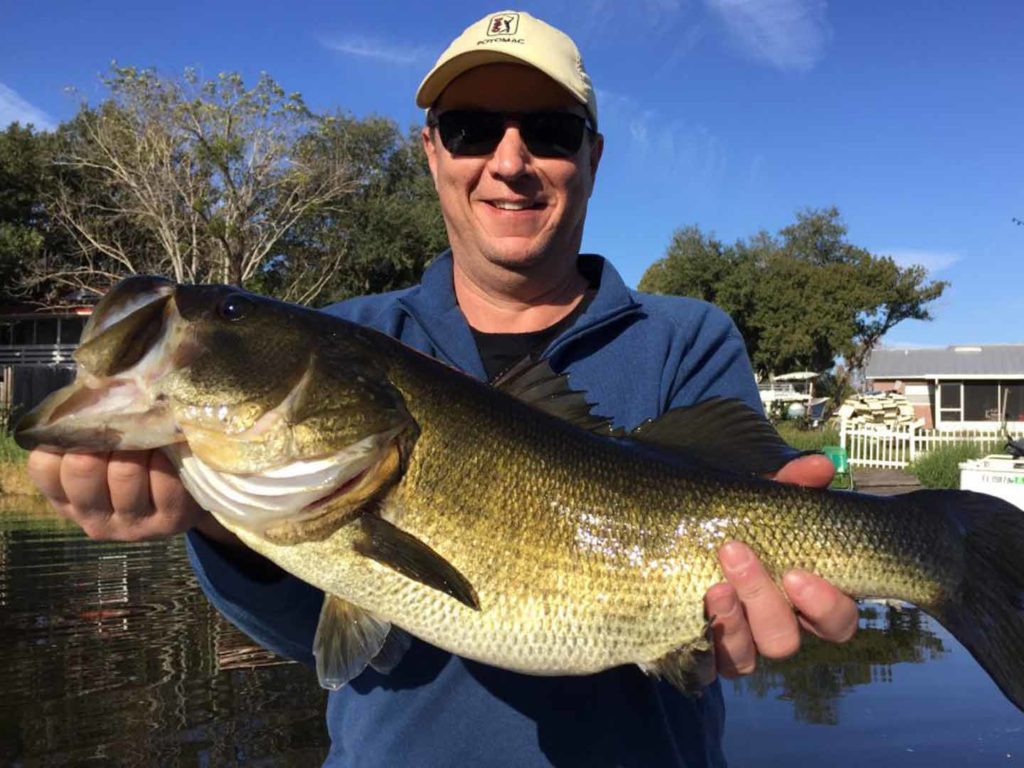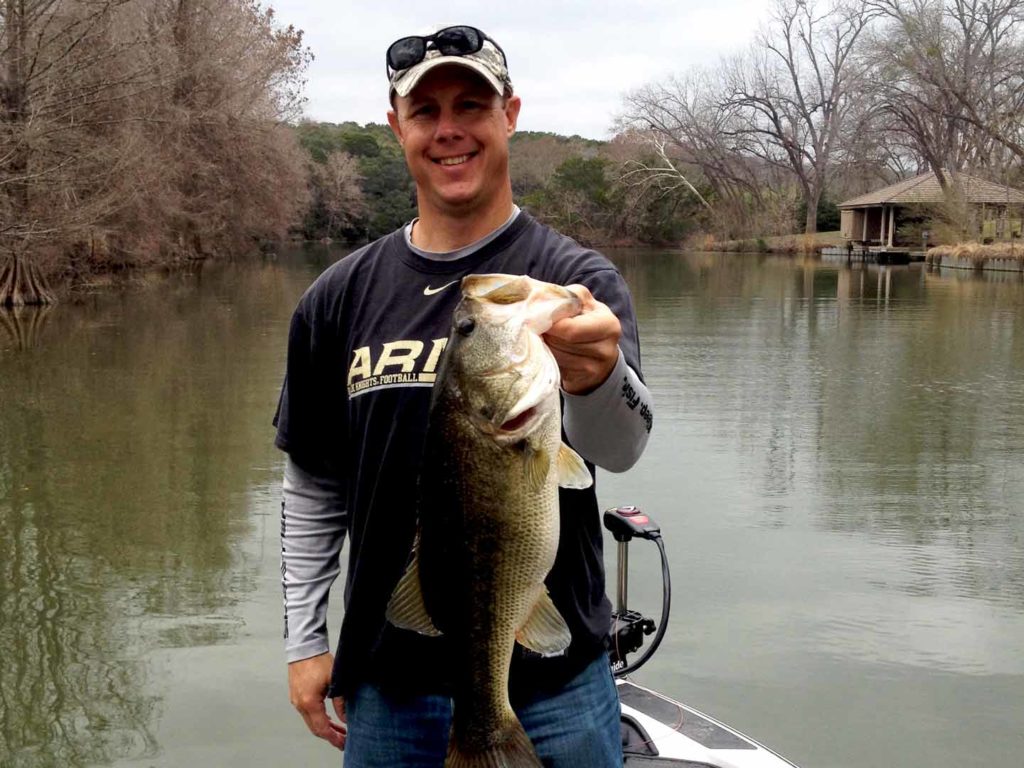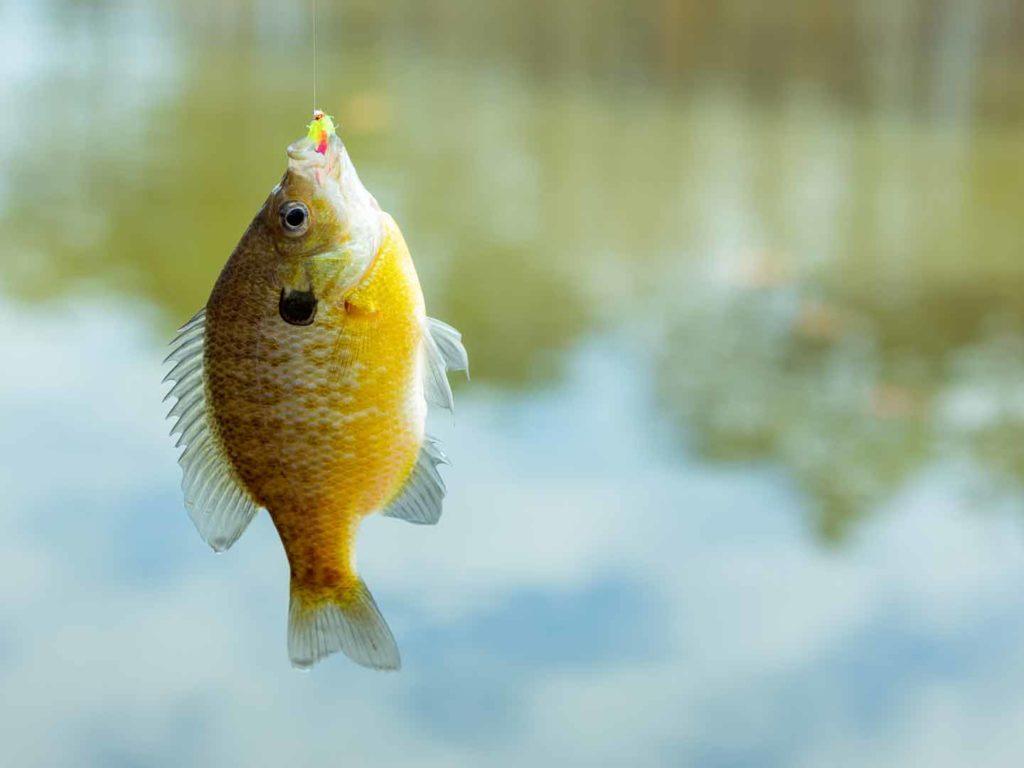While there’s no denying the spring spawning season is a great time of year to target Bass (especially big ones), Bass fishing during the fall season is a fantastic opportunity for the avid angler.
Beginning around September, the fall weather patterns begin to set in. This means increased wind, decreasing temperatures, and shorter days. It may not be the pleasant weather associated with summertime fishing, but it’s a dinner bell for Bass if you know where to look.

As water temperatures begin to decrease, and low-pressure systems increase, this creates a transition in the Bass behavior. They’ll begin to emerge from their deep stable temperature hangouts, and start venturing into mid-depth and shallow water flats, pockets, and creeks in search of food.
Fall is also the time of year when all of those summer-born bait fish are now reaching perfect eating size. Bluegill, shiners, and shad all born during the summer months are now 2–4 inches big and trust me, the Bass are hungry and on the hunt!
By understanding this change in Bass behavior and following their movement as the fall season unfolds, you can catch a lot of fish and have the lake to yourself most of the time.
How to Fish for Bass in the Fall

To catch Bass during the fall season, let’s break it down into two steps. First, focus on finding the transition areas from deep (summer) habitats into the shallower and mid-depth habitats. Second, after you find a suitable transition area, look for the bait! Specifically, look for features within the habitat that Bass can use to ambush and corral bait fish. That is precisely where you want to fish. Let me explain:
Check Transition Areas
During the hot summer months, Bass are staged in stable and cool water. This usually means deep areas, such as reservoirs, channels, or pits. As the water temperature drops during the fall, Bass will emerge from these deeper haunts and head shallow, stopping off at different transition areas along the way.
The challenging part is finding these transition areas that are holding fish.
Ledges, humps, and ditches are all underwater terrain features associated with transitions from deep to shallow. Depending on your lake this may also include submerged timber, points, or troughs.

You may have to do some homework and cover some water, but systematically checking these areas is the first step to locating fall Bass. As water temperatures drop, and the days get shorter, Bass will move on and off these transition areas, following the bait and looking for any feeding advantage they can find.
Follow the Bait
During the fall, Bass feed heavily. Not only as they emerge from the slow and sluggish summer months, but because they are trying to load up before the cold winter months set in. Large schools of shad and shiners will also be moving this time of year, and if you can find an area where they are present, you’re in luck!
Quality electronics can detect schools of bait beneath the surface, but keep an eye out for diving birds and surface wakes from bait schools. And don’t be afraid to look shallow – sandy spots in the shallow flats are excellent ambush spots for Bass feeding on sunfish and minnows.
Where to Fish for Bass during the Fall
Shallow Flats (Pre-Spawn Areas)
Depending on the water temperature in your area, fall Bass will push shallow in search of bait. The best way to find Bass in shallow water is to systematically break it down, starting deeper and working your way shallow until you get some bites.

If you know where Bass typically spawn during the later winter and spring, you’re in the right neck of the woods.
Creek Mouths
Creek mouths are the perfect transition habitat from deep to shallow water habitat. During the fall, Bass can stage anywhere from the deep water coves in front of creeks, all the way back into the creeks themselves.
Cover the water with a fast-moving bait to locate fish, then focus in on the areas that produce bites. And keep in mind, Bass can move in and out of these creek mouths in a very short period of time, depending on the weather and water temperatures.
Flowing Water
Bass will take advantage of flowing water or current to stage an ambush on passing bait fish. If your lake or pond has a spillway, tidal influence, bridges, culverts, etc, these can be a goldmine!
Pay attention to the flow of the current, and how the water moves around structure. Look for eddies, upflows, and overflow areas to push around bait.
Structure

One of my favorite things to look for during the fall is a long boathouse or dock that extends out into deeper water. These structures provide cover for Bass and often attract bait fish feeding on plankton and algae growing on pilings.
It’s even better if these structures are adjacent to those deep water refuges Bass use during the hottest months.
Hint: The bigger the boat on the lift, the deeper the water required for it to operate.
What Are the Best Baits for Bass fishing during the Fall?
For live bait, you can’t go wrong fishing shad, shiner, or live bluegill. These are predominantly what Bass feed on during the fall season.

If you fancy using live bait, rig a golden shiner on a 3/0 circle hook under a cork. Use just enough weight to keep the shiner from swimming to the surface and slowly paddle or troll around. This is a fantastic way to pinpoint Bass, then bust out the artificial lures and have some fun!
Best Lures for Bass Fishing during the Fall
For fall Bass fishing, stick with large profile baits that are big and aggressive in natural colors.
Sometimes you need to cover a lot of water to find fish, as they are in a constant state of transition. Once you find the fish, slow down and pick them apart with more refined lures that entice a bite. Here are my top 5 favorites:
Senko Worm
The Senko worm is one of my favorite fall Bass lures due to its versatility. For example, If I’m looking to cover a lot of shallow water, I’ll rig it weedless with no weight, and swim it along the surface right over weed mats, duckweed, and pads.

If I’m trying to pick apart a deeper area, I’ll tie a Carolina rig and use it to probe deep weed beds or rocks for suspended Bass. The Senko worm works in all 4 seasons, but during the fall it does very well, especially in a black/purple color or white/sunfish color.
Swimbaits
Swimbaits have really taken off in recent years, and they are one of my favorite lures to throw during the fall. No other lure mimics a big shad or bluegill better than a realistic swimbait.
After I have located an area holding Bass (such as a shallow cove) I’ll start throwing a big wake swimbait. You won’t get as many bites, but those you do are going to be quality-sized fish.
Crankbaits
Ask any serious Bass angler what to use during the fall, and I’d bet all of them will say a crankbait. No other lure covers water like a crankbait, and with so many varieties in sizes and types, you can target specific depths until you find fish.

Break down an area systematically, by starting with your deepest running crankbaits, and work your way shallow. Let the bites tell you where the fish are. Experiment with your retrieve speed, and throw in an occasional pause.
Flukes
A weedless split-tail fluke is a great way to fish a soft bait in a weedless presentation that really excels around structure. It’s perfect for flicking under docks, boat houses, and stump fields.
If you happen to see schools of threadfin shad getting busted on the surface, tie on a fluke and get ready. I like to use a “twitch-twitch-pause” cadence and match my color to what the Bass are feeding on. If that doesn’t work, pick a color that really stands out! Bubblegum pink, chartreuse, or red/white are some of my favorites.
Chatterbait
Chatterbaits are a big aggressive lure that resembles the profile of a sunfish and gives off an irresistible action. This lure is best for mid-to shallow water fishing and is my go-to lure when I am spooking fish in 6 feet of water or less.
Hint: In early fall before the temperatures get too cold, a chatterbait at night is a great way to pick up big Bass hunting in the shallows.
Final Thoughts on Fall Bass Fishing

Fall Bass fishing does not have to be complicated, and it’s a great time of year to catch fish without the pressure of big crowds or boat traffic. First, focus on locating likely transition areas adjacent to deep summer habitat. Then, dial in on locating the bait. Look for big schools, submerged bait pods, scattered fish, and diving birds.
Once you’ve found transition areas with bait, focus on likely ambush areas. Boat houses, docks, bridges, highwalls, flowing water, and anywhere else where bait fish will have a disadvantage. The Bass won’t be far behind. Good luck!
The post Fall Bass Fishing: All You Need to Know appeared first on FishingBooker Blog.
https://ift.tt/xjAyrtu
0 Comments
Enregistrer un commentaire